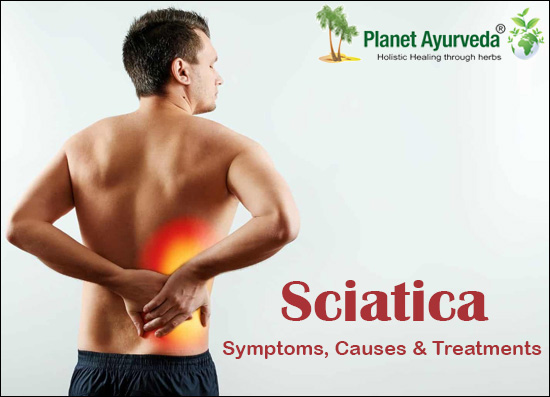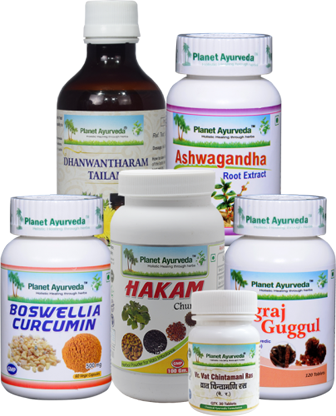Top 7 Natural Ways To Help Getting Relief From Sciatica
Sciatica is the irritation, inflammation and compression of the nerve which runs to the lower back and legs. Sciatica usually irritates the sciatic nerves, which involve tingling and numbness. Nerves are the cables which carry electrical impulses between the brain and the rest of the body. Nerve cells are known as Neurons and they are present all over the body, especially in the brain and spinal cord. There are two types of nerves- Sensory (carry signals to the brain and are helpful in touch, taste and smell) and Motor nerves (Signals to muscles and glands which are useful in moving and functions). Nerves are the makeup of the peripheral nervous system wrapped around tissue and fat layers. In this article, we are going to discuss Sciatica, its uses and the Ayurvedic view in detail.

Introduction
Sciatica is a degenerative condition of the leg and a very painful condition which usually radiates down to the leg. The sciatic nerve is the longest and thickest nerve in the body which runs from the back through the buttock and to the legs below the knee. Back Pain is usually seen in all shapes and sizes, which can appear slowly after injury which can be acute or chronic. Sciatica is also known as Lumbar radiculopathy which is the main nerve of the leg which is the bundle of nerves which comes from roots of 5 nerve branches from the spinal cord.
Types Of Sciatica
- True Sciatica – It is the injury which directly affects the Sciatica Nerve.
- Sciatica Like Condition – In This condition, it feels like sciatica but there are many reasons which are related to the Sciatic nerve which bundle together to form it.
How Sciatica Works?
- Sciatica usually starts from a herniated disc (lower spine), Round, flat discs of connective tissue separate and protect the bones that make up your spine.
- Due to injury, the disc gets turned out and it begins to push the hard outer ring.
- When the disk gets herniated it pushes pressure on the nerves around it which causes a lot of pain which is due to the Sciatic nerve.
- Bone Spurs and the Narrowing of the spine also put pressure on the Sciatic nerve which causes a lot of pain and problems.
Causes Of Sciatica
Sciatica is a common symptom which occurs due to various medical conditions, 90% of Sciatica is due to Herniated Disk. Three sections make up the spinal column:
- Vertebra
- Nerves
- Disks
Disks are made up of cartilage which act as a cushion between vertebrae and allow the spine to be more flexible. Cartilage is a strong and tough substance.
Other Causes Of Sciatica Are
- Stenosis of Lumbar spine
- Spondylolisthesis (disk slips forward over vertebrae)
- Tumors on the spine
- Infections
- Injury in the spinal area
- Cauda Equina Syndrome (nerves are affected in the lower part of the spinal cord)
- Obesity
- Poor Posture
- Piriformis Syndrome
Symptoms Of Sciatica
- Pain – Sciatica is due to pressure on the affected nerve which is a burning or shooting type like an electric shock. The pain usually radiates down to the leg region and can commonly be seen with coughing, sneezing and lifting legs upwards.
- Tingling sensation – It is like a pins and needles sensation (Paresthesia) in the feet and toes.
- Numbness
- Muscle Weakness
- Urinary and fecal incontinence
Diagnosis Of Sciatica
- X-Ray
- MRI
- Blood Tests
- Straight Leg Test
- Electromyography
- Myelogram
Treatment Of Sciatica
- Self Treatment – It may include-
- Ice compression – It is helpful in reducing pain and swelling when the sciatica pain starts. Apply it for 20 minutes several times a day.
- Heat Compression – After a cold impression, apply hot compression for 20 minutes to get relief from discomfort.
- Stretching and Activity
- NSAIDs
- Conservative Treatment – It may include –
- Painkillers, Muscle relaxants and anti-seizure medications
- Physical Therapy
- Spinal Injections
- Surgical Options
- Diskectomy
- Laminectomy
Ayurvedic View
In Ayurveda, Sciatica is known as Gridhasi, which is a typical Vata Vyadhi. Gridha means Eagle, as the affected person walks like an Eagle and its nerves which are inflamed or affected are like the beak of an Eagle.
Nidana Of Sciatica
- Intake of Vata aggravating food such as Bengal gram, Peanuts, red lentils
- Excess intake of dry, cold and light food
- Excess intake of Pungent, bitter and astringent food
- Suppression of urine and fecal matter
- Injury
- Heavy lifting and improper sitting positions
- The improper activity of panchkarma (Enema and Purgation)
Types Of Sciatica
- VATAJA GRIDHASI – Vataja Gridhasi has –
- Curved posture of the leg and body
- Shooting type of pain
- Stiffness
- The tingling sensation in joints, waists and knees.
- VATAKAPHAJA GRIDHASI – It is easily treated
- Indigestion
- Anorexia
- Drowsiness
- Excessive salivation
- Poor appetite
Samprapti Ghatak
- Doshas – Vata and Kapha
- Dushya – Rakta, Mamsa, medo
- Adhisthana – Kati, jaanu, janga, Uru
- Srotas – Raktavaha, Mamsavaha, Medovaha, Asthivaha
- Sroto Dushti – Sanga
- Agni – Mandagni, Vishvamagni
- Sadhya-Asadhya – Krichsadhya
Line Of Treatment
PANCHKARMA
- Snehana (Oleation) – Sprinkling of oil over the affected area.
- Swedana (Sudation) – Application of Patrapinda Sweda, Upnaha Sweda is beneficial in Sciatica.
- Mridhu Samshodhana – It is Mild Purgation
- Basti – Medicated Enema
- RaktaMokshana – Bloodletting it is advised to perform it 3 inches above or below the knee joint.
Herbs Useful In Sciatica
- Nirgundi – Nirgundi (Vitex negundo) is helpful in pacifying the Vata doshas which is helpful in suffering from joint and Nerve pain. Nirgundi has anti-inflammatory properties as it inhibits prostaglandin synthesis which is responsible for pain. Nirgundi is astringent in taste and it is useful in Vata-Kapha disorders. In Sanskrit, Nirgundi is the wonderful gift of mother nature which promotes the overall health of humans.
- Rasna – Rasna (Pluchea lanceolata) Rasna is a perennial herb which is situated in North West India and reaches a height of 30-60 cm. Rasna contains Moretenol and Stigmasterol which have anti-inflammatory and anti-oxidant properties. Rasna inhibits the oedema up to 30.52%. Rasna leaves are helpful in expelling ama doshas (endotoxins) to improve the mobility of joints.
- Shigru – Shigru (Moringa oleifera) Shigru is a small, deciduous tree which is a native herb to India and sub-Himalayan regions. This herb is helpful in balancing Vata and Kapha doshas, the leaves and bark of Shigru are helpful in reducing severe pain. It is anti-inflammatory in nature and is rich in calcium and magnesium which improves the strength of bones and various disorders.
- Ashwagandha – Ashwagandha (Withania somnifera) is commonly known as winter cherry, which is traditionally used as medicine and a dietary supplement. This herb is helpful in improving strength and immunity, has anti-inflammatory properties which provide relief to the pain in joints and is useful in Arthritis thus maintaining the proper flow of blood in the body. This plant is commonly known as the odour of the horse, ashwagandha acts as a pain reliever which prevents the signals of pain from travelling to the central nervous system.
- Curcumin – Curcumin (Curcuma longa) is a yellow bright colour substance which is useful in alleviating various conditions and blocks the inflammatory cytokines and enzymes including COX-2. Curcumin is helpful in relieving sciatica pain and swelling by lowering levels of certain inflammation-fueling enzymes.
7 Natural Ways to Get Relief From Sciatica
1. Home Remedies
- Hot or Cold Compresses
- The use of hot or cold compresses can help relieve sciatica pain and inflammation. Heat treatment relaxes tense muscles that may be compressing the sciatic nerve.
- You can also alternate heat and cold, starting with the hot compress and ending with the cold compress.
- For heat treatment, you can use a steamed towel.
- For cold, ice cubes covered with cloth can be used.
- Place a hot or cold pack on the affected area for 15 to 20 minutes.
- Do this every few hours until you get relief.
- Turmeric
- Add 1 teaspoon of turmeric to 1 cup of milk. You can also add a small cinnamon stick. Boil the solution. Sweeten this healthy drink with honey and drink it once or twice daily until you see improvement.
- Another option is to take 250 to 500 mg Curcumin supplements such as Planet Ayurveda’s Curcumin Capsules, 3 times a day for several weeks.
- Massage
- Epsom Salt Bath
Note: If you have circulatory problems then avoid the cold compress.
Turmeric is the most common spice used in the kitchen which is packed with various medicinal properties like anti-inflammatory and antioxidants. It contains a compound called curcumin that helps reduce nerve pain and inflammation.
How to Use?
Note: Turmeric may not be suitable for those taking blood thinners or diabetes medications. Those suffering from gallstones should also avoid it.
Massage is one of the beneficial therapies that work on muscle spasms, pain, and numbness in the legs and toes. Massage the affected area with herbal oil, 2 or 3 times a day until you get relief.
Another option is to add 3 tablespoons of nutmeg powder to 1 cup of sesame oil. Heat the mixture. Allow it to cool and massage the affected area with it when it is comfortably warm. Do this a few times a day for a few weeks.
Epsom salts are known to relax the nervous system and draw toxins out of your body, and can be found in any local drug store. Fill the bath with hot water and add 2 cups of Epsom salt. Soak your leg or foot / affected area for about 15-20 minutes. The heat will also increase circulation and reduce inflammation.
2. Planet Ayurveda’s Herbal Remedies For Sciatica (Sciatic Nerve Pain)
Planet Ayurveda provides the best combination of effective herbal remedies such as the Sciatica Care Pack for the ayurvedic treatment of sciatica. These herbal remedies are prepared by using best quality herbs and strictly follow the principles of Ayurveda. All these herbal remedies of Planet Ayurveda are 100 per cent pure, natural and vegetarian. These are free from chemicals, additives and preservatives. The herbs used are safe and free from side effects.
Products List
- BOSWELLIA CURCUMIN
- HAKAM CHURNA
- ASHWAGANDHA CAPSULES
- YOGRAJ GUGGUL
- VRIHAT VATCHINTAMANI RAS
- DHANWANTHARAM TAILAM
Dosage
- Boswellia Curcumin – 2 capsules twice daily after meals with plain water.
- Hakam Churna – 1 teaspoon twice daily after meals with plain water.
- Ashwagandha Capsules – 1 capsule twice daily after meals with plain water.
- Yograj Guggul – 2 tablets twice daily after meals with plain water.
- Vrihat Vatchintamani Ras – 1 tablet twice daily after meals with plain water.
- Dhanwantaram Tailam – Apply gently on the affected site of the body and keep it for 6-8 hours at least for best results or As Directed by the physician.
Products Description
- Boswellia Curcumin – Boswellia-Curcumin is a polyherbal capsule formulation manufactured by Planet Ayurveda using Shallaki (Boswellia serrata) and Curcumin (Curcuma longa). These capsules have anti-inflammatory and immunomodulatory effects. Curcumin targets the pathway which blocks the cytokines including COX-2 which provides relief from pain and inflammation. Shallaki acts as a pain killer which promotes natural lubrication and has shock-absorbing properties.
- Hakam Churna – Hakam Churna is a polyherbal powder formulation which is made by Planet Ayurveda using Chandrashoor (Lepidium sativum), Kalonji (Nigella sativa), Methi (Trigonella foenum graecum) and Ajwain (Trachyspermum ammi). It is useful in balancing Tridoshas and has anti-inflammatory properties which are useful in relieving chronic conditions such as Rheumatoid arthritis and sciatica. Vata is responsible for body pains so this churna is helpful in pacifying Vata and Kapha doshas which provides instant relief from pains.
- Ashwagandha Capsules – Ashwagandha Capsules is a single herbal capsule which is formulated by planet Ayurveda using a standardized extract of Ashwagandha (Withania somnifera). It is an evergreen shrub commonly known as Indian Ginseng or Winter Cherry. Ashwagandha capsules are helpful in improving immune function and reducing inflammation. The roots of Ashwagandha have an anti-inflammatory effect in inhibiting the MAPK (mitogen-activated protein kinase) Pathway which further regulates cytokines. It also protects the cells damaged which are caused by free radicals.
- Yograj Guggul – Yograj Guggul is a polyherbal tablet formulation which is made by Planet Ayurveda using various ingredients such as Guggul (Commiphora mukul), Amalaki (Emblica officinalis), Gokshura (Tribulus terrestris), Rasna (Pluchea lanceolata) and many more. Pain in the joints or any body part is due to an imbalance of Vata doshas so Guggul has hot potency and vata balancing properties. Hence, Yograj Guggul is useful in Pain and inflammation. Yograj guggul is also useful in maintaining the digestion and metabolism of the body and supports healthy muscles and joints.
- Vrihat Vatchintamani Ras – Vrihat Vatchintamani Ras is a classical Ayurvedic tablet formulation which is made by Planet Ayurveda using Swarna Bhasma (Calx of gold), Rajata Bhasma (Calx of silver), Abhraka bhasma (Calx of Mica) and many more. This tablet is useful in enriching the vital tissues of the body and pacifying the Vata doshas. Is an excellent rejuvenator and helpful in the treatment of Neuromuscular and musculoskeletal disorders. Vrihat VatChintamani Ras is helpful in supporting healthy digestion and in the proper functioning of the brain.
- Dhanwantaram Tailam – Dhanwantharam Tailam is a classical Ayurvedic product which is an oil preparation made by planet ayurveda using Bala Moola (Sida cordifolia), Yava (Hordeum vulgare), Bilva (Aegle marmelos), Shyonaka (Oroxylum indicum), Shalaparni (Desmodium gangeticum) and more. Dhanwantharam Tailam has a cooling effect which soothes and stimulates nerve cells which stimulate the nervous system. Dhanwanthram Oil is useful in vata disorders which improves the muscles, ligaments and other tissues of the body.
3. Herbs
- Turmeric – Turmeric has a chemical constituent which is packed with anti-inflammatory properties and can help relieve sciatica pain and swelling by lowering levels of certain inflammation-fueling enzymes. It can be taken in the form of tea, in cooking, or even applied topically in a paste for the best benefits.
- Garlic – Like turmeric, garlic also has amazing anti-inflammatory properties, making it a great sciatica pain treatment. Increase your use of garlic in all your dishes, but also consider taking it with pure extract as a supplement like Garlic capsules (Planet Ayurveda). Consume daily at least four raw cloves each morning. It helps to fight pain and also to boost your immune system.
- Valerian Root – Valerian root works as a relaxant and relieves chronic nerve pain. It is particularly good for easing sciatica pain caused by a muscle spasm. This herb contains volatile oils that help relax your muscles and ease tension.
How to Use?
You can drink valerian tea prepared by steeping 1 teaspoon of dried Valerian root in 1 cup of hot water for 10 minutes. Drink this herbal tea several times a week for a few weeks.
4. Diet
There are certain foods that can help alleviate the pain and improve the structure and functions of the nerves.
Foods you should include in Your Diet are:-
- Fibre Rich foods- such as Whole wheat bread, Brown rice, Split peas, Lentils, Black beans, Lima beans, Artichokes, Broccoli, White gourd, Pomegranate, Apples, Blackberries, Figs, Dates, etc.
- Magnesium-rich foods such as Dairy products, Fish, Meat, Seafood, Apples, Apricots, Brown rice and Lima beans.
- Foods Rich in Omega 3 Fatty Acids such as salmon, sardines, herrings, mackerel, tuna, black cod, trout, halibut, flaxseeds and walnuts.
- Vitamins A Rich Foods such as Dairy products – Milk, Cheese and Yoghurt, Carrots, Dark green leafy vegetables and Orange-coloured fruits.
- Vitamin C Foods include Oranges, Grapefruits, Pineapples, Tomatoes, Spinach, Mustard greens, Strawberries, Cherries, Cantaloupe regular and Sweet potatoes, Cabbage, Broccoli and Green and yellow vegetables.
- Vitamin K Sources such as Broccoli and Spinach, Alfalfa, Vegetable oils and Cereals.
- Vitamin B6 B6-rich foods include Bananas, Garbanzo beans, Peanut butter, Tomato juice, Spinach, Soybeans, Sunflower seeds, Walnuts, Poultry and Wheat bran.
- Vitamin B9 Rich Foods such as Asparagus, Beans, Peas, Lima beans, Whole grains, Mushrooms, Liver, Broccoli, Orange juice, Avocados and Turnip greens.
- Vitamin B12 Rich Foods such as Oysters, Crab, Tuna, Salmon, Beef, Lobster, Lamb, Liver, Swiss cheese, Mozzarella cheese, Parmesan cheese, Eggs and liver.
- Potassium-rich foods include White beans, Dark leafy greens, Potatoes, Apricots, Avocadoes, Mushrooms, Fish (salmon) and bananas.
5. Yoga Poses
If you’ve had the pleasure of taking a yoga class, you know how beneficial it can be for relieving almost any kind of pain.
- The Standing Back Twist – Place your foot on a chair and put the outside of your opposite hand on your raised knee (left hand to the right knee or right hand to the left knee). Keep your other hand on your hip. Turn your upper body while keeping your hips facing forward, hold the position for thirty seconds, then switch. Repeat this process several times.
- The Knee Raise – Lie on your back and draw one knee to the chest while keeping the other leg straight and resting on the floor. Press it against your chest, pushing it as far down as you can, and hold the position for 30 seconds. Repeat the procedure on the alternate side.
- The Two Knee Twist – Lie on your back. Splay your arms to form a capital “T.” Keeping your shoulders on the floor, turn your knees out to one side. Keep your shoulders on the floor. Hold the position for a minute, then alternate sides.
- The Single Knee Twist – Lie on your back. Keeping one leg straight, twist one knee to a 90° angle and keep the opposite hand on that knee. Turn to face the arm still on the floor. Keep both shoulders against the floor.
- The Twisted Lunge – This is a trickier pose but really opens your hips. Step one leg forward and bend at the knee. The other leg should stay out behind you. Try to keep your feet one leg’s length apart. Turning your back, place your opposite elbow on the outside of your bent knee. Bring your palms together. Hold for thirty seconds.
6. Exercise
- Ardha Bhujangasana – Ardha Bhujangasana is the best exercise which helps with lumbar disc prolapse and lower back pain.
- Low back muscle strengthening exercise – Upper back extension. In this pose, hands clasped behind the lower back, raise the head and chest slightly against gravity while looking at the floor (stay low). Begin by holding position for 5 seconds, and gradually work up to 20 seconds. Repeat the whole procedure for 8-10 times.
- Abdominal muscles strengthening exercise – Curl-ups. For the upper abdominals, the patient should lie on the back with knees bent, arms folded across the chest, and the pelvis tilted to flatten the back. Then curl up lifting the head and shoulders from the floor. Hold for two to four seconds, then slowly lower to the starting position. Increase the number of sets slowly. Do not attempt to lift the head up too high, and bring the head and chest towards the ceiling. For patients with neck pain, place the hands behind the head to support the neck.
Special Instructions
- Do Not exercise when there is pain
- Rest is the only solution
- Exercise may worsen the condition during the acute phase
7. Tips For Sciatica Patients
- Do some light sciatica exercises such as light walking and jogging. Do not exercise if your condition is extremely painful.
- Avoid Sitting for Long Periods, Get Moving – Sitting for many hours, such as working at a desk or watching TV during leisure time, can make matters worse when it comes to bulging discs and back pain.
- Take care of your diet as mentioned. Avoid curd, chickpeas, kidney beans and rice mainly.
- Drink ample water.
- Keep yourself busy, read good books and do some activities like painting so that your mind gets diverted from pain and discomfort.
To buy Sciatica Care Pack, please visit store.planetayurveda.com/products/sciatica-care-pack
Conclusion
The pathways which carry electrical impulses through the brain to the rest of the body are referred to as nerves. Neurons, additionally referred to as nerve cells, are found throughout the body, especially in the brain and spinal cord. The sciatic nerve, which travels from the back down the buttock and to the legs below the knee, is the longest and thickest nerve in the body. Further, we discussed the Ayurvedic concept of Sciatica with 7 natural ways of getting rid of the pain of sciatica along with herbal supplements from planet ayurveda in detail.
FAQs
1. What is Sciatica?
Sciatica is pain that originates from the back and radiates down to the lower limbs. This is usually seen in younger and middle-aged individuals. It is known as Neurogenic claudication which refers to pain, discomfort and heaviness in the calf muscles around the butt or during walk or standing.
2. What are the causes of Sciatica?
Sciatica is caused by a Slipped disc, overgrowth of the bone, Slippage of one bone over the other or some overgrowth in the spinal canal.
3. What is a Slipped Disc?
The spine is made up of a number of bones which are known as Vertebrae, one over the other. These Discs act as shock absorbers which allow some movements between two vertebrae to provide some flexibility. When this disc slips it compresses the spinal cord and the roots of the nerves which leads to many problems.
4. How does Sciatica affect the quality of Life?
Sciatica pain extends from the lower back from the thighs to the foot region. The pain can come and go from days to some weeks, which makes you feel discomfort and affects the quality of life. If the nerve is damaged it leads to numbness, tingling sensation and weakness in the legs.
5. How much rest do you need for Sciatica?
In many cases, Sciatica may go away within 4-6 weeks. More severe cases of Sciatica need weeks or months to get better.
6. What are the Do’s and Don’t of Sciatica Nerve Pain?
Do’s
- Seek good medical treatment
- Maintain a healthy weight
- Be careful with your diet
- Use hot and Cold therapy
Don’t
- Don’t Smoke
- Don’t lift heavy objects incorrectly




